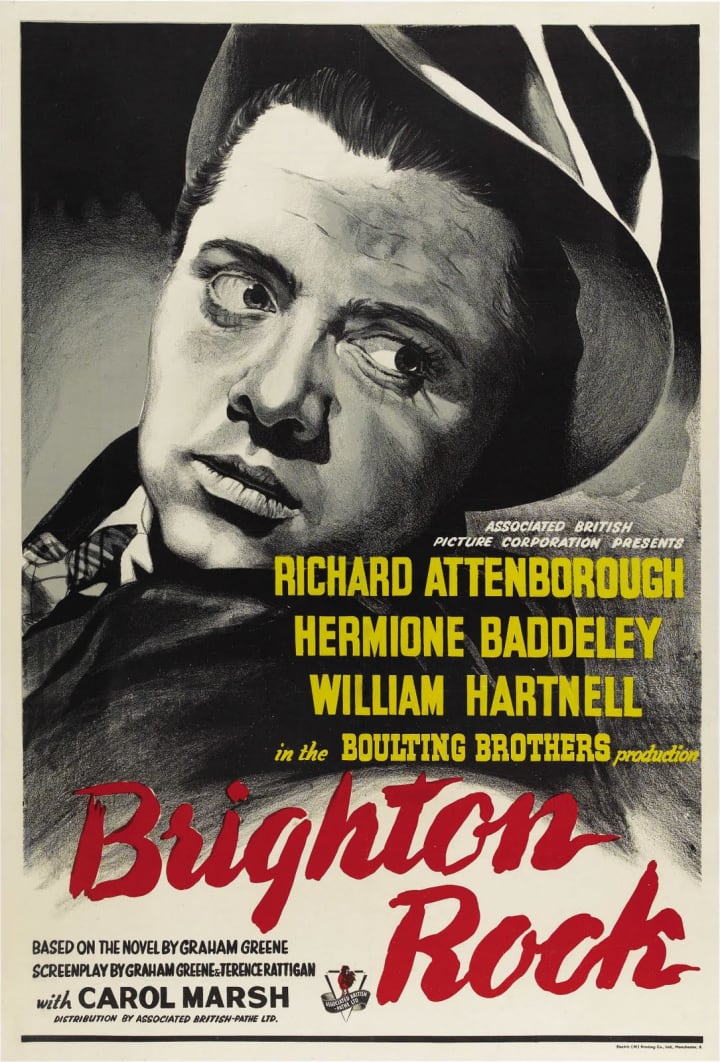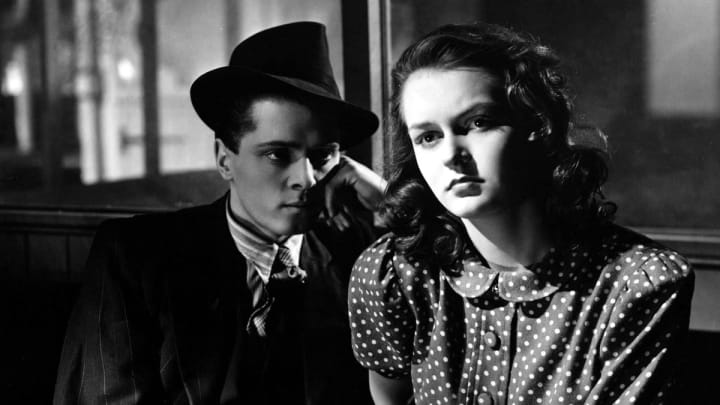Mastering Murder Mystery: from Hitchcock till today
Collect classic crime stories without regretting any minute!

A Cinematic Guide No. 1: Crime and Mystery
FOREWORD:
Years spent on film festivals had opened my horizons and taught me the most important lesson: if you want to gain knowledge of the real cinema, you have to follow the directors. So since then, I’m walking step by step on the path prepared by: Jim Jarmusch, Wim Wenders, Derek Jarman, Lars von Trier, Pedro Almodóvar, Luis Buñuel, François Truffaut, François Ozon, Xavier Dolan, Federico Fellini, Ingmar Bergman, Krzysztof Kieślowski, Roman Polański, and tons of more… But there’s also of course enticing mainstream and eternal classics. In “The Cinematic Guide” I’ll try to share with you my fascination with the cinema the way I see it, showing most relevant, important, and acclaimed from artistic point of view “productions”. Be prepared for the most valued knowledge straight from the screening room, film creators, and film festivals.
And the film journey continues…
“STRANGERS ON A TRAIN” (1951)
Wanna hear one of my ideas for a perfect murder? The “light socket in the bathroom” or the “carbon monoxide in the garage”? Oh, that reminds me of a wonderful idea I had once. I used to put myself to sleep at night figuring it out. Now, let’s say that you’d like to get rid of your wife. Let’s say you had a good reason. You’d be afraid to kill her. You know why. You’d get caught. And what would trip you up? The motive. Ah… Now, here is my idea. Listen, it’s so simple too. Two fellows meet accidentally, like you and me. No connection. Never saw each other before. Each one has somebody that he’d like to get rid of. So, they swap murders. Each does the other’s murder. Then there’s nothing to connect them. Each one has murdered a stranger. Like you do my murder, I do yours. For example, your wife, my father. Crisscross.
Alfred Hitchcock’s ageless recipe for a perfect murder followed the simplest rule in the film’s life: how to keep the audience entertained and intrigued yet not bored with a cliché. He widely achieved this by building up the suspense step by step, almost on the side, as the murder would be a decoration to a tea party. The strength of his movies lays down not in keeping a secret to its very end, but in knowing everything what’s the most important from the start and building up the tension to buy his spectators’ emotions. That’s why when Bruno’s exposing himself in public as the ladies’ man (Hitchcock’s representations of the villains were usually positive pleasant personalities with whom we could easy identify) and an expert in explaining the excellent method of murder whilst trying to suffocate Mrs. Cunningham for fun, it’s not a revelation for us that he’s the killer, only for the certain characters within the movie who unfortunately happen to not know his previous experience and for whom he’s a stranger. However, by appearing face to face with the subject everything seems clear enough to deduct that the plot itself isn’t thrown to them at random at all.

Good evening. Today I’ll try to debunk some of the greatest movies in a long and short memory of film history. I’ll put under a microscope the originals and convince the unconvinced that its worth to be immersed in the black and white world every now and then to feel the ambience of dragging danger breathing down your neck and not spurts of blood saturating the screen. Mister Hitchcock stayed far away from this. His method involved psychological aspects leading the characters to the motives of their behaviours, suggestion, and creating anxiety and fear by the cunning combinations of the details. That is why in “Strangers on a Train” for instance we don’t see clearly the murder’s face during the horrid act and we are obliged to follow the director’s rule and look in the mirror of murderee eyeglasses lens. Master of suspense was known for appealing to the audience’s intelligence and imagination – instead of stale scaring, he often took symbols of everyday life possessing positive context to the viewers’ (like shower or an amusement park for instance), and played with them to achieve the negative (read: desirable) effect. Merry-go-round plunged into a horror movie influences spectators’ subconscious minds to reverse every knowledge they have happened to acquire about this phenomenon since their childhood. Almost like he could say to us: “Hey, this time won’t be fun, I guarantee it! You’ll see violence, but I won’t show it to you. You’ll see it by your mind’s eye!” The scream and the laughter were always going hand in hand in his motion pictures.
Hitchcockian style, apart from avoiding monsters (as not humans, as monstrous personalities permeated his pictures immensely) in horror movies, included making a good use of the attributes, characters, or events of plot with supposedly unimportant values. This was called MacGuffin and that’s how director himself explained the term in a 1939 lecture at Columbia University in New York City:
It might be a Scottish name, taken from a story about two men on a train. One man says, 'What's that package up there in the baggage rack?' And the other answers, 'Oh, that's a MacGuffin'. The first one asks, 'What's a MacGuffin?' 'Well,' the other man says, 'it's an apparatus for trapping lions in the Scottish Highlands.' The first man says, 'But there are no lions in the Scottish Highlands,' and the other one answers, 'Well then, that's no MacGuffin!' So, you see that a MacGuffin is actually nothing at all.
In “Strangers on a Train” MacGuffin is tennis champ’s cigarette lighter (left with Bruno on a train) which is perfectly used by the villain later on with an attempt to Guy’s blackmail and incrimination, ultimately unsuccessfully.
Irrationality, perverseness, and subversiveness in a crave to commit a crime by everyone of us, a normal person, were often subjects of Hitchcock’s work. Duality, split identities, moral ambiguity attracted director and were profoundly prized parts of Hitchcockian style, where both villains and heroes were mixed up. “Strangers on a Train” was based on the acclaimed first novel by Patricia Highsmith. Decent Guy commits murder in the book, in Hitchcock’s adaptation – doesn’t, what can be strictly connected with Hollywood moralistic ending and intervention of the censors. Still, what’s more important lays down in the way leading to the action, crooked camera filming buildings during Guy’s entering it or passing by – high angles swimmingly suggest danger in the appearance of Bruno chasing tennis champ everywhere with his deviant plan. Hitchcock’s innovational shooting techniques were well-known for creating illusion, along with the depiction of middle-aged monstrous motherly figures constantly placing their sons as the apple of their eyes what was widely connected with the director’s own relationship with his mother. The screen of master of suspense movies is also occupied with Hitchcock’s blondes (although in “Strangers on a Train” this place is taken by the astounding brunette) and director himself in a short cameo appearance in his every work.
„BRIGHTON ROCK” (1948)
If you’ve seen Hitchcock’s “Strangers on a Train”, you have to watch “Brighton Rock” next, even if only for the same motif of a murder in the amusement park. The movie was also based on the famous novel, this time by Graham Greene written ten years earlier, in 1938. Although experience of WWII had changed the human mentality between the time when novel was written and the time the movie was produced, the presented story didn’t lose any authenticity and actuality. “Brighton Rock” from the book and the movie depicts Brighton from the 1930s during British gangs fighting. In this Boulting brothers’ film noir we follow the steps of the seventeen-year-old gangster Pinkie Brown (played by phenomenal, although criticised by the author of the book, Richard Attenborough) whose perpetual growing violence is closely observed by the local police, more powerful competing Calleoni’s gang, and middle-aged brassy singer Ida Arnold. The suspicious woman begins her own investigation to help to resolve the case of Fred Hale’s disappearance as she doesn’t believe neither in Fred’s suicide nor the heart attack as ruled by the police. The kind-hearted Ida tries to persuade Rose, whom Pinkie married to avoid her giving incriminating evidence against him, that Brown’s a villain, yet Rose is besotted with love. After Rose’s discovery of one of “Kolley Kibber’s” cards in the restaurant where she works and connection the facts that the person who left them wasn’t Fred (it was Pinkie’s gang mate Spicer), she’s becoming an unsafe interest of the Pinkie’s gang. Greene’s murder thriller is continuing the plot started in his previous novel, “A Gun for Sale” (1936), where cold-hearted assassin Raven murdered gang boss Kite allowing immature Pinkie to take over the risky business.

Original “Brighton Rock” movie (in 2010 was released modern adaptation directed by Rowan Joffé) was criticised for the violent razor-slashing crime scenes and even forbidden to release in New South Wales (Australia), apparently at the time where the most horrifying incidents were happening in the real life in the 1930s Sydney. The sentimental happy ending also met with criticism (from the author of the book too), as it differs from the original version of the story. In the movie Rose is convinced till the end that Pinkie had loved her which proves the recording he made for her. The damaged gramophone needle is spinning around the words: “I love you”, although full version of handsome antihero’s words (which we hear in the booth during recording) was much cruel, not leaving Rose any hope, only hate. But once again, censors were most likely to reject the original paper ending appearing to be too tragic for the viewers. Nevertheless, knowing the truth would be “The greatest horror of all” as Greene was convinced. In spite of all that, film was quite popular among British audience, gaining less attention in United Sates where was released under the changed title “Young Scarface” and considered not that violent there.

The film and the book, despite depicting depraved underworld, openly deal with the subject of Roman Catholicism – one of the often motifs in Greene’s literature. Both Rose and Pinkie declare themselves as believers, yet each of them is placed on the opposite side. Rose represents struggle of the individual soul seeking salvation through good deeds, whilst Pinkie’s perspective oscillates mostly around hell. Perhaps that’s his main motor motive leading him to the brutal acts within his razor gang, however consciousness of the damnation commands him to cover his treacherous tracks of the multiple murder in his mug’s life. In the world where sin is ubiquitous, there’s no escape from it and villain’s destiny, as well as innocent girl's, is doomed from the beginning. Greene seems to wink his eye to the audience saying: “Who else is going to be more interested in corruption than a Catholic?” Rose appears to be a perfect dramatic character who knows how to suffer, similar to tragic Bruno captured in the train’s locomotion.
“THE BIG SLEEP” (1946)
This American film noir was the first adaptation of Raymond Chandler’s novel from 1939 under the same title. The plot follows investigation of the professional private eye Philip Marlowe (Humphrey Bogart) in a Sternwood’s case. As the film was about to be released after the war, it includes few hints of the wartime production: pictures of president Franklin D. Roosevelt, calling dead bodies “red points” meant to refer to meat rationing during the war, and also “B” gasoline rationing sticker in the lower passenger-side window of Marlowe’s car implying that he was allowed eight gallons of gasoline per week as his business was essential for the war effort.
To underline “Bogie and Bacall” phenomenon started by the couple’s appearance in “To Have and Have Not” (1944) and also in opposition to the mediocre critical response to Lauren Bacall’s previous movie “Confidential Agent” (1945), actress’s agent requested the parts of the movie to be re-shot, re-edited, and revised. Then the new scenes taking advantage of the chemistry between both actors were added (such as sexually suggestive racehorse dialogue – see below), as well as some old scenes with previous actors were eliminated and others added again (performance of Peggy Knudsen as Mona Mars for instance due to unavailability of the originally casted for this role Pat Clark). Two versions differ by twenty minutes, yet the actual difference in running time is only two minutes. Performance of the actress playing Carmen (Martha Vickers) dimmed Bacall’s (Vivien) to the high degree that producers had to remove some of the scenes including Vickers to intensify Bacall’s leading role.
Bacall: “...speaking of horses, I like to play them myself. But I like to see them work out a little first. See if they're front-runners or come from behind... I'd say you don't like to be rated. You like to get out in front, open up a lead, take a little breather in the back stretch, and then come home free....”
Bogart: “You've got a touch of class, but I don't know how far you can go.”
Bacall: “A lot depends on who's in the saddle.”
Improved version of the movie was released on cinema’s screen on 23 August 1946. At this time, “The New York Times” film critic Bosley Crowther said the film leaves the viewer “confused and dissatisfied”, points out that Bacall is a “dangerous looking female” who “still hasn't learned to act” and notes:
“The Big Sleep” is one of those pictures in which so many cryptic things occur amid so much involved and devious plotting that the mind becomes utterly confused. And, to make it more aggravating, the brilliant detective in the case is continuously making shrewd deductions which he stubbornly keeps to himself. What with two interlocking mysteries and a great many characters involved, the complex of blackmail and murder soon becomes a web of utter bafflement. Unfortunately, the cunning script-writers have done little to clear it at the end.
This might be the effect of the partly omitted long conversation between Marlowe and the LA District Attorney where some facts of the case are presented, yet intense Bogart-Bacall duet seems to be more valued by the movie enthusiasts than the well-told story.
In the middle of 1990s in the UCLA Film and Television Archive was found original pre-release version of the movie – director Howard Hawk’s 1945 cut. It was first shown to the military troops in the South Pacific. The original restored copy was released in the art-house cinemas in 1997 with an appropriate documentary comparing cinematic and content differences between director’s film noir and the Warner Brothers mainstream version.
Film critic Roger Ebert in 1997 wrote:
As for the 1946 version that we have been watching all of these years, it is one of the great film noirs, a black-and-white symphony that exactly reproduces Chandler's ability, on the page, to find a tone of voice that keeps its distance, and yet is wry and humorous and cares. Working from Chandler's original words and adding spins of their own, the writers (William Faulkner, Jules Furthman and Leigh Brackett) wrote one of the most quotable of screenplays: It's unusual to find yourself laughing in a movie not because something is funny but because it's so wickedly clever. (Marlowe on the “nymphy” kid sister: “She tried to sit in my lap while I was standing up.”) Unlike modern crime movies which are loaded with action, “The Big Sleep” is heavy with dialogue – the characters talk and talk, just like in the Chandler novels; it's as if there's a competition to see who has the most verbal style.
As for the times when film was produced, the screenplay must be accepted by the censors at the Hays Office. Geiger’s pornography business from the initial Chandler's book and his homosexual relationship with his chauffeur Carl Lundgren are not mentioned in the movie, as those subjects (illegal pornography associated with a crime, explicit references to sexual orientation) were then forbidden. Also, appearance of Carmen couldn’t be nude as Chandler characterised. Therefore, she’s wearing a “Chinese dress” and is sitting in the “Chinese chair” in the photographs, and she presents herself in Marlowe’s apartment fully dressed.
Raymond Chandler collaborated on a screenplay to Hitchcock’s “Strangers on a Train” before being thrown out by the director himself. Nonetheless, he retained his screenwriting credit along with Czenzi Ormonde. Personally, I recommend to compare the similar sequences embellishing both movies and crisscrossing their paths: the beginning of “Strangers on a Train” with two different pairs of legs walking along the way to the train station and a pair of legs escaping the justice from the Geiger’s house in “The Big Sleep”. Although filmed in an ultimately incomparable style (the same is true about the amusement park from Hitchcock’s and Boulting brothers’ movie), they are both unforgettable.
“THE TALENTED MR. RIPLEY” (1999)
My intention is to focus on the Anthony Minghella’s adaptation of this Patricia Highsmith’s acclaimed psychological thriller from 1955 under the same title. First filmed version of the novel (although not survived) was produced for TV anthology series Studio One in 1956 and directed by Franklin J. Schaffner. First full-length adaptation called “Purple Noon” (French: Plein soleil) from 1960 was directed by René Clément with Alain Delon playing leading role and starting his career. There was also Claude Chabrol’s film “Le biches” from 1968 loosely based on Patricia Highsmith’s novel (yet not acknowledging it), but the genders of the main characters were switched.
In “The Talented Mr. Ripley” we’re coming back to the subject explored earlier by the Hitchcock’s movie and going to be involved in life of a shrewd sociopath and a civilised and pleasing psychopath Tom Ripley. Roger Ebert in the review for “Purple Noon” from 1996 illustrated him this way:
Ripley is a criminal of intelligence and cunning who gets away with murder. He's charming and literate, and a monster.
It's insidious, the way Highsmith seduces us into identifying with him and sharing his selfishness; Ripley believes that getting his own way is worth whatever price anyone else might have to pay. We all have a little of that in us.
In both “Strangers on a Train” and “The Talented Mr. Ripley” homosexual attraction from one side is evident yet not expressed openly, only materialised in a strong desire to change personality and become another man – that’s the essential role of the killer. That’s what ties both characters together. And similar to Bruno from the Hitchcock’s film, Tom is sophisticated and charming being in the same time a cold-blooded murderer.
Highsmith is describing Ripley as a “suave, agreeable and utterly amoral” con artist, career criminal, and a serial killer who can always escape justice. His covering of committed crimes places him near Pinkie from “Brighton Rock” to disadvantage of the latter one. He’s fascinated with young Greenleaf to that extent, that he’s utterly changing his personality in front of a carefree man, comfortably switching his interest from classical music performed in front of Dickie’s father to more light-hearted jazz. At least in the Anthony Minghella's movie. Mr. Greenleaf hired Tom to force his son to come back home – we can find the appropriate analogy also in “The Big Sleep” where General Sternwood is hiring Marlowe to somehow guard his two spoiled daughters having gambling debts and being drugged occasionally too. “The Talented Mr. Ripley” is just the first presentation of Tom Ripley’s character filling the pages of four more novels written by the American author. Roger Ebert in the same review of René Clément’s 1960 adaptation wrote:
Ripley in the later novels has become a committed hedonist, devoted to great comfort, understated taste and civilized interests. He has wonderful relationships with women, who never fully understand who or what he is. He has friendships – real ones – with many of his victims. His crimes are like moves in a chess game; he understands that as much as he may like and respect his opponents, he must end with a checkmate.
Nearly as Bruno – a hedonistic killer from Hitchcock’s movie – who firstly ate lunch with Guy on a train, and then murdered his wife. Pleasure to start with, then – homicidal act.
Modern adaptation of Patricia Highsmith’s crime fiction gained both positive and negative reactions of the critics, mostly depending on the personal taste or the fascination with charismatic Alain Delon. Personally, I would never switch this version of “The Talented Mr. Ripley” for anything else because of… music. Exactly! I love jazz! If you like it too, check it for yourself here:
Specially for this role Jude Law learned to play sax and Matt Damon learned to play the piano making quite astonishing performance too:
The second performance reminds me the atmosphere of the first Roman Polański’s film “Knife in the Water” from 1962.
Jazz is another main character in the movie. Count Basie, Duke Ellington, Dizzy Gillespie, Miles Davies, and Charlie Parker whose nickname "Bird” became also the name of Dickie’s boat in the movie. They’re all here, all the greatest. The movie is also a celebration of the Italy with its famous locations including the Spanish Steps and Piazza di Spagna in Rome, Venice, and few villages near Naples playing fictitious town “Mongibello”.
“KNIVES OUT” (2019)
And now ladies and gentlemen, “the last of the gentlemen sleuths”, crème de la crème – a powerful, colourful, and vibrant modern murder mystery show with Daniel Craig as a world-renowned private detective Benoit Blanc whose investigation, similarly to the Marlowe's in ‘The Big Sleep’, is only a pretext to dig the uncomfortable truths which in this case are different depending on the interrogated individual. Director and writer Rian Johnson (known from 2017 hit “Star Wars: Episode VIII – The Last Jedi” distributed by Walt Disney Studios Motion Pictures) among inspirations for his film mentioned many classic mystery comedies and thrillers such as: based on detective stories of Agatha Christie “Something’s Afoot”, “Death on the Nile”, “Murder on the Orient Express”, “The Mirror Crack’d”, and “Evil Under The Sun”; “The Last of Sheila” (1973 American neo noir mystery film), “Murder by Death” (1976 American spoof of Agatha Christie’s stories), “The Private Eyes” (1980 American comedy mystery film), “Deathtrap” (1982 American black comedy mystery film based on Ira Levin’s play), “Clue” (1985 American black comedy mystery film), and “Gosford Park”. Author’s inspiration, especially for the setting, set design, and the automaton Jolly Jack the Sailor, was also 1972 version of whodunit “Sleuth” – a British-American mystery thriller film directed by Joseph L. Mankiewicz. The title of the Johnson’s movie comes from 2001 Radiohead song “Knives Out” – Johnson’s favourite band (and mine too!). The name of the mystery writer from the film, Harlan Thrombey, has its beginnings in 1981 series of children’s gamebooks “Choose Your Own Adventure” Who Killed Harlowe Thrombey?
Daniel Craig is particularly provocative playing the character being on the opposite end to his agent 007 creation, with his “Kentucky Fried Foghorn Leghorn drawl” as described by Harlan Thrombey’s grandson, Ransom. It’s also worth to notice a new star in the Hollywood’s sky, Ana de Armas, who’s representing Latina and being in contrast with Thrombey family’s racist point of view of America. Keep an eye on this actress – she’s going to be the major player in the film business (if they ever allow us to come back to where we were before the pandemic). Exception that proves the rule, that hard-working immigrants are always ahead of the game.
Film had the world premiere at the Toronto International Film Festival in 2019 and gain critical acclaim for the screenplay, direction, acting, and earned over $300 million worldwide against a $40 million budget. Personally, I wouldn’t want to have a family like this, if I were a rich writer as Harlan Thrombey.
Closure
During the times when a “horror movie” means cramming the screen with monsters, beasts, and similar inhuman looking animals, we scarcely realise that this genre meant something distinct in the world of 1950s Alfred Hitchcock’s horror pictures. There was a different era and different style of filmmaking, yet the sad truth stays the same – the worst horror of all lays down within us, in a human condition.
These five presented above movies intertwine together, each forming a masterpiece in the hands of great directors, screenplays, and the books they’ve originated. Without them, they wouldn’t be what they are: wonderfully constructed pieces of art.
***
Thank you for reading!
If you liked this article, you can add your Insights, Comment, leave a Heart, Tip, Pledge, or Subscribe. I will appreciate any support you have shown for my work.
You can find more articles, stories, and poems by Mescaline Brisset on my Vocal profile. The art of creation never ends.
About the Creator
Mescaline Brisset
if it doesn't come bursting out of you
in spite of everything,
don't do it.
unless it comes unasked out of your
heart and your mind and your mouth
and your gut,
don't do it.
so you want to be a writer? – Charles Bukowski
Find me on Medium
Reader insights
Nice work
Very well written. Keep up the good work!
Top insights
Compelling and original writing
Creative use of language & vocab
Easy to read and follow
Well-structured & engaging content
Excellent storytelling
Original narrative & well developed characters
Expert insights and opinions
Arguments were carefully researched and presented
Eye opening
Niche topic & fresh perspectives
Heartfelt and relatable
The story invoked strong personal emotions
On-point and relevant
Writing reflected the title & theme






Comments (1)
Mescaline Brisset is not accepting comments at the moment
Want to show your support? Send them a one-off tip.